Liquidity in Saudi Arabia’s economy has demonstrated significant improvement so far this year, rising 9 percent year-on-year to an all time high of SAR2.898706 trillion ($772.37 billion) by the end of the second quarter of 2024.
According to the Saudi Central Bank‘s (SAMA) July statistical bulletin, the liquidity level in the second quarter surged by SAR238.15 billion ($63.46 billion) from SAR2.660556 trillion ($708.94 billion) during the second quarter of 2023.
Quarter-on-quarter, Saudi Arabia’s liquidity also expanded by 3 percent, rising SAR74.96 billion ($19.97 billion) compared to the end of the initial quarter this year when liquidity stood at SAR2.823745 trillion ($752.42 billion).
Since the beginning of the year, Saudi Arabia’s liquidity has grown 5.5 percent, rising by over SAR148.83 billion. By the end of July, liquidity reached SAR2.869788 trillion.
These robust liquidity levels serve as a catalyst for the Kingdom’s economic and commercial framework, contributing to economic development, in line with Vision 2030.
Read | 24 Fintech: $213 million fintech venture capital fund announced
Breaking down the four components of Saudi Arabia’s broad money supply (M3), demand deposits were the largest contributor at 49 percent or SAR1.421423 trillion by the end of Q2 of 2024. Meanwhile, time and savings deposits amounted to SAR903.712 billion, making them the second largest contributor at 31 percent.
The third major contributor to Saudi Arabia’s broad money supply (M3) was other quasi-monetary deposits, reaching SAR344.384 billion, or 12 percent of the total. Finally, currency in circulation outside banks stood at SAR229.187 billion, constituting about 8 percent of overall money supply.
For more news on banking & finance, click here.




